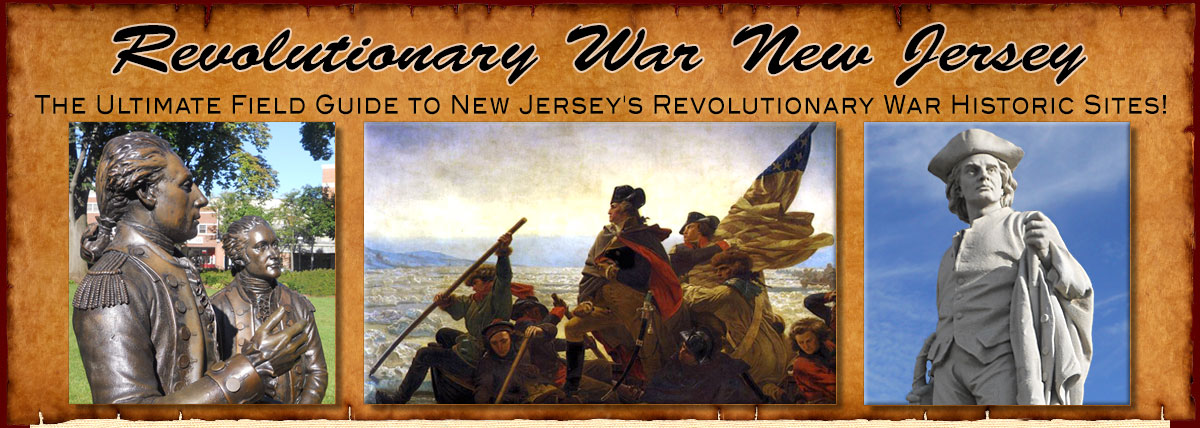

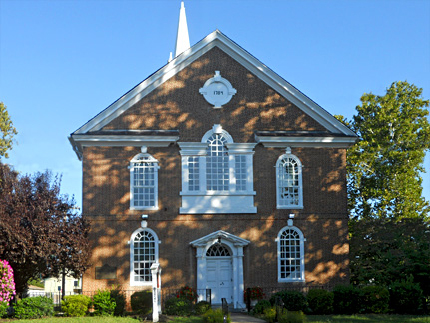
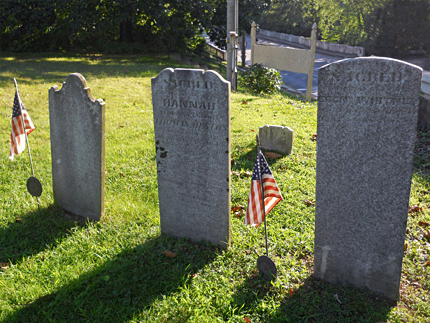
Trinity Episcopal Church
Kings Highway and Church St.
Map / Directions to Trinity Episcopal Church
Map / Directions to all Swedesboro Revolutionary War Sites
The church, which is now Episcopal, was originally Swedish Lutheran. The current church building was constructed in 1784. It replaced an earlier 1703 log church, which was in a state of disrepair, in part due to its occupation by soldiers during the Revolutionary War. Its minister during the war was Reverend Nicholas Collin, who had been born in Sweden. Collin began preaching here on June 3, 1770.
Reverend Collin kept a journal which was published in 1936. His journal is filled with interesting details about the effect of the Revolutionary War on himself, his church, and the citizens of Swedesboro.
On February 4, 1777, Collin was taken prisoner by militia and accused of being pro-English. In his journal he described the event:
"I followed them under close guard by a strong escort with loaded guns and fixed bayonets, and judging from their barbaric expressions I often expected death, especially as many were drunk and fired several salvos for their own amusement, - the approaching darkness would easily have hidden the true murderer. Their wish was, as I later discovered, that I should attempt to escape, for then they would have had a better excuse for such a low deed, but for this I was too wise. When we had covered a mile of the way Doctor Otto arrived, who was also one of the new magistrates, but a kindhearted man belonging to the German Lutherans, and obtained my release by going my bail."
Collin was allowed to remain in Swedesboro when he took an oath of allegiance to the United States "with explicit reservation to remain neutral and to do nothing which would be unworthy of me as a Swedish subject, and in case anything like that should be demanded of me I should be permitted to leave the place unhindered."
Collin writes that British troops took possession of the nearby section of the Delaware River in September of 1777, and that "from that time on, there was a constant alarm by straying parties and the militia marching to and fro; Divine services were often interrupted on account of it." The following month the Battle of Red Bank occurred about 12 miles from here at Fort Mercer, and the next day Collin went along with many people of Swedesboro to see the Battlefield.
American General Anthony Wayne, for whom the township of Wayne was later named, spent one night in 1777 at Collin's house, the church rectory. That original rectory, which had been built in 1765, was replaced on the same site by the current rectory (shown above right), which was built in 1854. Collin recorded the circumstances of General Wayne's stay in his journal:
"On the last of February the American General Vain [Anthony Wayne] passed through here with a detachment of 300 men, of whom the greater part were miserably clothed, some without boots, others without socks. He himself did not arrive until 12 o'clock at night and took up his quarters in my house. Just as he was about to go to bed, the sentries fired warning signals, but nothing happened, however. He was a well-bred gentlemen and showed me great respect. He left the following day, and on the morning at 11 o'clock, a regiment of English infantry came to attack him, but he had then already escaped. "
Collin remained the reverend here until 1786. The church then changed its affiliation from Swedish Lutheran to Episcopalian. The first Episcopalian minister of Trinity was John Croes, who had served as a Private in the Revolutionary War.
After leaving Swedesboro, Collin lived and preached in Philadelphia, where he became a prominent citizen. In April 1789, George Washington was traveling from his home in Virginia to be inaugurated the first President in New York City, which then served as the national capital. On April 20, he stopped in Philadelphia where an elegant reception was held in his honor. Collin served on the reception committee, and he was one of 250 attendees at the reception. The following day, Washington continued on his journey; he arrived first in Trenton, where he was greeted by an elaborate reception under a Triumphal Arch. He continued on across New Jersey over the next several days and was greeted with receptions along the way at Woodbridge, Rahway, and Elizabeth.
Collin knew and corresponded with Benjamin Franklin and Thomas Jefferson. When Philadelphia served as the national capital from 1790-1800, Collin regularly interacted with members of Congress. [1]
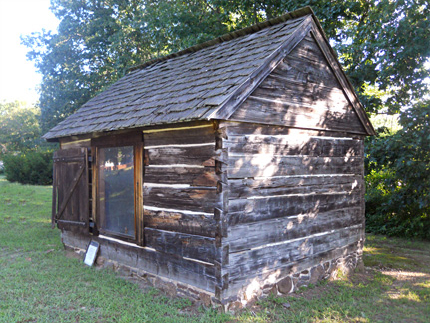
The Church Cemetery
The church's cemetery contains the graves of three known Revolutionary War soldiers: [2]
Colonel Robert Brown
(1741 - November 17, 1797)
Thomas Heston
(Died 1802)
Doctor Bodo Otto,
Jr. (House is in Mickleton, NJ)
(Born 1748 in Germany; Died Jan. 20, 1782)
The Mortonson-Van Leer Cabin, also known as the Shorn Log Cabin (pictured left), is also located within the cemetery. A marker at the cabin states that it "is one of the oldest log cabins of early Swedish Finnish architecture in the United States." It originally stood at the north bank of the nearby Raccoon River. The cabin has no direct Revolutionary War connection; however, it was built by Morton Mortonson, whose grandson John Morton signed the Declaration of Independence for Pennsylvania. [3]

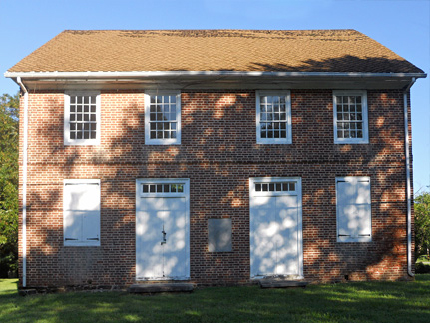
Moravian Church
Kings Highway and Moravian Church Rd.
Map / Directions to the Moravian Church
Map / Directions to all Swedesboro Revolutionary War Sites
This church building was constructed in 1786. It replaced a log church which had stood nearby. The log church, which had been erected in 1747, was used to house British troops. [4]

1. ^ The majority of information in this entry, including the quotes from Collin's journal, were drawn from:
Nicholas Collin, Amandus Johnson, Journal and Biography of Nicholas Collin 1746 -1831 (Philadelphia: The New Jersey Society of Pennsylvania, 1936)
• The quotes related to Collin's capture and oath of allegiance appear on pages 237-238
• Collin's account of the events of September/October 1777, including the "From that time on..." quote, appears on pages 243-244
• The quote about General Wayne appears on pages 243-244
• Collin's account of the new church being built 1784-1786 appears on 291-296
• A description of the Washington in Philadelphia event appears in the biography section of the book on page 100 -103
• Descriptions of Collin's communications with Jefferson and Franklin, including letter transcriptions, appear on pages 114-116, 120,192,198-199▸ I highly recommend this book, particularly the section which reprints Collin's Journal, to anyone who would like to read a fascinating firsthand account of the effect of the war on ordinary citizens in this area.
Collin's writing style is wonderful. I have read a great deal of letters and journals from the Revolutionary War era during my research for this project. Collin's journal is among the very best written documents I have encountered. Even though he is often recounting sad and tragic events, his writing always shines through.
While working on this entry, I found myself wanting to quote many large portions of his journal. Because that would have been outside the scope of this website, I settled on the several quotes that do appear.
• Information the church's switch to Episcopalian, the 1854 date of the new rectory, and minister John Croes was drawn from the History section of the Church's website.
2. ^ Information about the soldiers graves was drawn from gravestones and markers in the cemetery, and from Swedesboro, NJ - Alive with History / A Guide to Who's Buried in the Cemeteries of Swedesboro brochure, which is available as a PDF on the Historic Swedesboro website.
3. ^ Informational text at the cabin.
4. ^ A stone tablet on the building (visible between the two doors in the photo), which was placed by the Gloucester County Historical Society on August 31, 1907, states, "Near this site A.D. 1747, the Moravians erected a log church which was dedicated August 31, 1749 o.s. by Bishop A. G. Spangenberg. The construction of this church was begun in June 1786 and dedicated July 5, 1789 by Bishop J. Ettewein."
• The Moravian Church page in the Historic Sites section of the Gloucester County website states that the log church "housed British troops during the Revolutionary War" but does not specify a date.